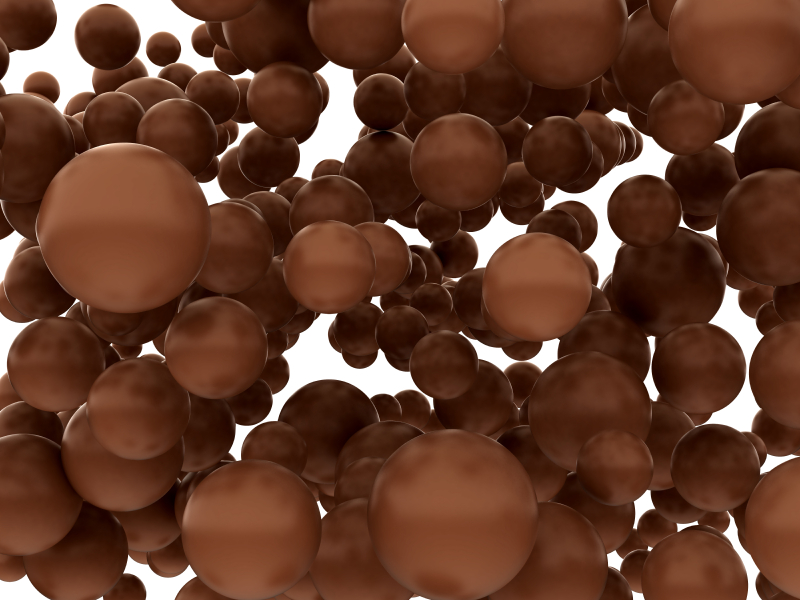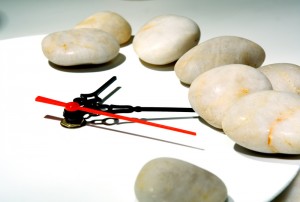Wednesday Bubble: Yes, you can!
If you are anything like me, you may not always think you can, even though you are capable, smart and talented. And as women, we often find ourselves questioning our abilities (even though we are capable, smart and talented). For example, when was the last time you asked for a salary increase? Or defended yourself against a bully? Or took the bull by the horns and made that change that you’ve been telling yourself that you are going to make for a zillion months? Well? When?
No worries, because I’m not going to go all kumbaya on you. It’s not my style. But I would like to share my own ‘yes, you can’ moment, in hopes that it might motivate at least one person to take the first step they’ve been procrastinating about taking.
Let’s talk about taking the bull by the horns, aka, there’s no time like the present. First, a bit of context.
The last quarter of 2011 was a trying time for me. Business issues became all consuming, I was traveling a lot, sleeping a little, drinking too much and had swayed from diet. All of which add up to zero. And by the end of this time, I ended up a few pounds heavier, exhausted and truly out of balance. Not a great way to start a new year. And hence, my body revolted, forcing me not only to slow down but to stop entirely; I contracted a viral infection of the inner ear that resulted in terrible vertigo. And if you have ever had vertigo, you know that it ain’t pretty. Or fun.
This year, I have made a few promises to myself, mostly, to shed those couple of pounds that are hanging on, improve my eating habits and try the hardest to stay balanced. The latter part of this does not necessarily jive with my A type personality but so far it’s working. But more importantly? Yesterday I challenged myself to run a 10k at the gym. And I completed it in a fairly good time. Although once an avid runner, I have not run any admirable distance in decades. And it felt really good, AND dragged me out of the January doldrums. Mostly though? I realized that I can; I can get back into a healthy groove, maintain some calm, rethink where I am in my life right now and if it’s where I want to be. And if not, I can define what’s next on the horizon and work towards making it happen. Because, I can kick it. I can run a 10K if I feel like it.
Guess what? So can you.
Promise me that the next time that little voice in your head starts to talk you out of taking a step, even it’s a baby step, that you’ll pause and tell yourself “yes, I can.” And then just try…cuz:
Before this did you really know what life was,
Comprehend to the track for its wide cos,
Gettin mentions on the tip of the vibe buzz,
Rock ‘n’ roll to the beat of the funk fuzz,
Wipe your feet really good on the rhythm rug,
If you feel the urge to freak do the jitter bug,
Come and spread your arms if you really need a hug…
[Lyrics: A Tribe Called Quest]
Kumbaya? Maybe a wee little bit. Wednesday? No bubble this week. Just a little inspiration and whole lot of admiration..
Kick it.
Read MoreWant to change the quality of your life? Bust a move
The next time you place blame on hormones as the reason for things not going so well in your life, you may want to step back and move. I’m not talking about locale, but rather, moving your body. And researchers are saying that physical activity may actually be one of the most important things you can do to maintain or improve the quality of your life when hormones are wreaking havoc on your body, your mood and your outlook.
Granted, part of the reason for the improved life quality may have to do with amelioration of symptoms as a result of exercise. Indeed, you may recall a post from last month discussing the value of setting aside a precious hour for yourself for some sort of brisk activity. This new study adds fodder to the discussion, and suggests that even moderate increases in physical activity can improve overall life quality.
Importantly, this study, which involved over 1,100 women who were followed via questionnaire over 8 years, showed that a change in menopausal status acted as prompter to increase physical activity, and these women tended to experience greater improvements in their life quality than their peers who didn’t exercise or whose physical activity decreased over the time period. What’s more, as a side note, women in the study who never used hormone replacement therapy reported having a better quality of life than women who did use it, and even had 1.26 greater odds for improved life quality.
While the reasons for this are unclear, the researchers say that exercise may increase the production of endorphins, which in turn, work on symptoms, stabilize the body’s temperature regulation system and smooth out the flashes, sweats and other symptoms. However, most important is the point that the implications are far greater than feeling good: menopause may actually be a ‘window of opportunity’ to start improving your life by making healthier lifestyle choices.
But what do they mean by “exercise?” In this particular research, participants were asked to characterize their activity levels by:
- The time spent on heavy physical activity on the days they exercise at least 10 minutes
- The time spent on moderate physical activity on days they exercise for at least 10 minutes
- Time spent on brisk walking on days they walk for at least 10 minutes
This information was then translated into metabolic equivalent (MET) hours per week, which measures basal metabolism and the amount of oxygen the body uses during exercise. You can find more information on MET as it relates to specific activities here.
The sum of all parts equals one thing: move. It’s important for symptoms, it’s critical for weight and it’s essential for health. And it appears to be the gold ring when it comes to life quality.
What are you waiting for?
Read More
Wednesday Bubble: not for naught, brown fat
 Okay, so it doesn’t quite rhyme. But brown fat is rearing it’s head again and this time, it’s the New York Times. I love the New York Times, don’t get me wrong. But the headline of a piece on brown fat, coupled with the information that follows, is a perfect example of raising hopes before dashing them.
Okay, so it doesn’t quite rhyme. But brown fat is rearing it’s head again and this time, it’s the New York Times. I love the New York Times, don’t get me wrong. But the headline of a piece on brown fat, coupled with the information that follows, is a perfect example of raising hopes before dashing them.
Let’s start with the headline:
Feel a Chill? Brown Fat’s Busy Slimming You Down
And the second paragraph:
“It is brown fat, actually brown in color, and its great appeal is that it burns calories like a furnace. A new study finds that one form of it, which is turned on when people get cold, sucks fat out from the rest of the body to fuel itself. Another new study finds that a second form of brown fat can be created from ordinary white fat by exercise.”
Let’s step back and take a look at brown fat. And then I can share the details of the research that the writer is referring to, and where her reporting is a wee bit misleading.
As I wrote about a year or so ago:
In mammals, fat (known among the medical set as “adipose tissue”) comes in two varieties: white and brown.
* White adipose tissue (or “WAT”) is used for energy storage and to provide warmth. It also protects the organs by acting as a cushion. Most of the fat in our bodies is white.
* Brown adipose tissue (or “BAT”), is mostly found in newborns and tends to diminish as a person ages. Brown fat is used by the body to regulate temperature and quickly burns sugar to keep infants warm, meaning that exposure to cold activates brown fat cells. This last point may be important when it comes to weight loss.
For decades, brown fat was believed to significantly decline as we grew older, mainly because as we become more able to regulate our body temperatures, we no longer solely rely on biology. However, PET scanning has shown that healthy adults actually have stores of brown fat scattered throughout the front and back of the neck and chest areas.
So, is brown fat an equal opportunist? NO!
In fact:
* Women with lean body mass have at least twice the ratio of brown fat compared to men.
* Exposure to temperatures of around 61º F appears to kick off brown fat cell activity, at least in leaner people.
* The higher your body mass index (BMI), the lower the amount of brown fat in your body.
Turning down the thermostat can help lose weight, right? Well yes. And no.
In controlled situations, volunteers left “chilling” for at least two hours were shown to have a surge in brown fat activity. However, keep in mind that the body is fine-tuned to maintain equilibrium, so, what goes out often goes right back in. In other words, expend more energy, eat more food. And the “chill factor” hasn’t been extensively tested in people under normal, everyday conditions. Still, based on what researchers are able to learn from animal studies, they believe that having as little as 1 to 2 ounces of brown fat in your body could potentially burn about 20% of the average daily caloric intake, that is, if brown fat cells were properly activated.
In the current study (published in the Journal of Clinical Investigation and referred to by New York Times writer Gina Kolata), researchers exposed six men between the ages of 23 to 42 of normal weight, to simulated cold conditions (using a thermal conditioned suit that enabled them to perfuse chilled, 32 degree F water, through it). The men were exposed to the room temperatures for 120 minutes and then cold temperatures for 180 minutes, cold enough to lower skin temperature but not cold enough to induce shivering, which burns calories. During these conditions, the researchers measured the metabolism of the fat using a PET scan. The results? They were able to show for the first time that while metabolism increased by as much as 80% (which is equivalent to around 250 calories burned during exposure to cold for three hours), there were clear differences in results between the men; this suggests that there are individual distinctions in brown fat volume. They also mention in the published study that they cannot exclude how or if other tissues might contribute, tissues that are not captured during the PET scan of this nature, such as the heart and other deep internal organs.
In the second study, which appears in Nature journal, researchers identified a protein in mice that enhances particular gene expression in muscle. In turn, this releases a hormone – iricin – that appears to convert white fat cells into brown cells. If the same were proven true in humans, it might mean that calories burned during exercise was due, at least in part, to this phenomenon. And if there was a way to enhance it, it might lead to more effective fat burning during exercise.
Notice that there area lot of ‘ifs’ in that sentence.
So, let’s go back to the original statement:
“…brown fat burns calories like a furnace. A new study finds that one form of it, which is turned on when people get cold, sucks fat out from the rest of the body to fuel itself. Another new study finds that a second form of brown fat can be created from ordinary white fat by exercise.”
Yeah, not so fast. When it comes to brown fat, you may want to consider all the facts before you turn down that thermostat and turn up the internal furnace., such as, there’s not enough data…yet.
Not for naught, or nothing.
Read More
Wednesday Bubble: when it comes to chocolate, walk the walk
You know all that dark chocolate you started eating after Monday’s post about chocolate and heart disease? Well, ‘Wednesday’s child is full of woe,’ mainly because overconsumption of high energy food sources, like chocolate, can lead to slow weight gain over time.
Damned if you do and damned if you don’t, right?
Not so fast! I ran across an interesting piece the other day when researching chocolate. And researchers say that while chocolate is one of the most commonly craved foods because it can temporarily enhance moods and may even be considered addictive, exercise may be a way to counter the chocolate craving, especially in the workplace where snacking is used as a tool to counter boredom, fatigue and stress.
In this small study, researchers asked regular chocolate eaters (i.e. those who confessed to eating at least two chocolate bars a day) to abstain from eating chocolate for two days and then randomly participate in the following:
- 15 minutes of exercise (a brisk walk on a treadmill to the point but not exceeding breathlessness) and a low demanding computer task
- 15 minutes of exercise (as above) and a high demanding computer task
- Rest and a low demanding computer task
- Rest and a high demanding computer task
Now, here’s the rub. During the computer tasks, participants were seated next to a bowl of chocolates and informed that they could dig in as they wished (and, the bowl was weighed before and after so that the researchers could accurately determine how much chocolate was eaten). And, despite temptation, the participants who exercised ate half as much chocolate as those who didn’t. Yet, stress didn’t seem to counter the effect of exercise or the temptation to snack since both high and low demanding tasks resulted in pretty much the same level of chocolate consumption.
Although this is a very small study and only mimicked real life conditions, evidently, others have likewise shown that a brisk walk can temper chocolate cravings and that walking for as little as five minutes can counter an urge to snack. This is especially interesting when it comes to addictive foods like chocolate, since the compulsion component of addiction is such a strong driver of unhealthy behaviors.
The next time you’re at work and feel compelled to reach for the chocolate? Take a break and walk around the block. Save the chocolate for relaxing evenings at home. After all, home is where the heart is.
Read More
Just 60 minutes a day…
keeps the symptoms at bay?
You know that I’m all about exercise, not only to maintain fluctuating weight but also to chase those moody blues away . But did you know that increasing your workout to at least 60 minute a day may actually improve wellbeing and lessen menopausal symptoms?
I stumbled across this piece last week and just knew that I had to share. And I am especially interested because it appears that too much exercise can set off early menopause (I’m still looking into this story). But to the study at hand.
Researchers, intrigued by the relationship between physical activity and menopausal symptoms, randomly assigned menopausal women to one of three groups:
- Less than 30 min/day physical activity
- Maintained or increased physical activity from 30 to 6o min/day
- Maintained or increased their physical activity to more than 60 min/day
During the time that participants were studied, their regular, habitual activity was defined as whenever they did something active for at least 10 minutes, e.g., household chores, transportation, etc. Additionally, all were encouraged to be more active (e.g. taking stairs versus an elevator) or at the very least, maintain their current activity levels during the time that they were enrolled in the 12 week study period.
Granted, while the outcomes were modest, the research did show that women who engaged in moderate to rigorous activity for at least an hour a day benefitted both in terms of feeling more positive about themselves and begin able to focus as well as in their personal relationships compared to peers who did 30 minutes or less a day. Overall, almost all menopausal symptoms were also lessened with the highest degree of physical activity. And, the researchers likened the improvements in mental wellbeing to the ability to, at the very least, maintain weight.
An hour of moderate physical activity daily? That’s a lot when your life is filled to the brim and your hours, maxed out. But, at the same time, mid age changes in body composition, hormonal fluctuations and increased risk of heart disease all point to one conclusion: it may be worth it to make the time. If you can’t get to the gym, at least take the stairs.
Treat yourself. You’re worth the hour.
Read More







